De Bethune DB25 Midnight Blue Reviewed by Tim Mosso
by Tim Mosso
Often in life, there’s a stark difference between perception and reality. Perception is one-part personal prejudice and one-part experience; it’s a construct. Reality, on the other hand, doesn’t care what perception thinks.
De Bethune, a small brand with very few watches in circulation, often find itself working against the perception that all its watches are wild and crazy. The reality is that quite a few are classically simple.
The DB25 Midnight Blue is one of those.
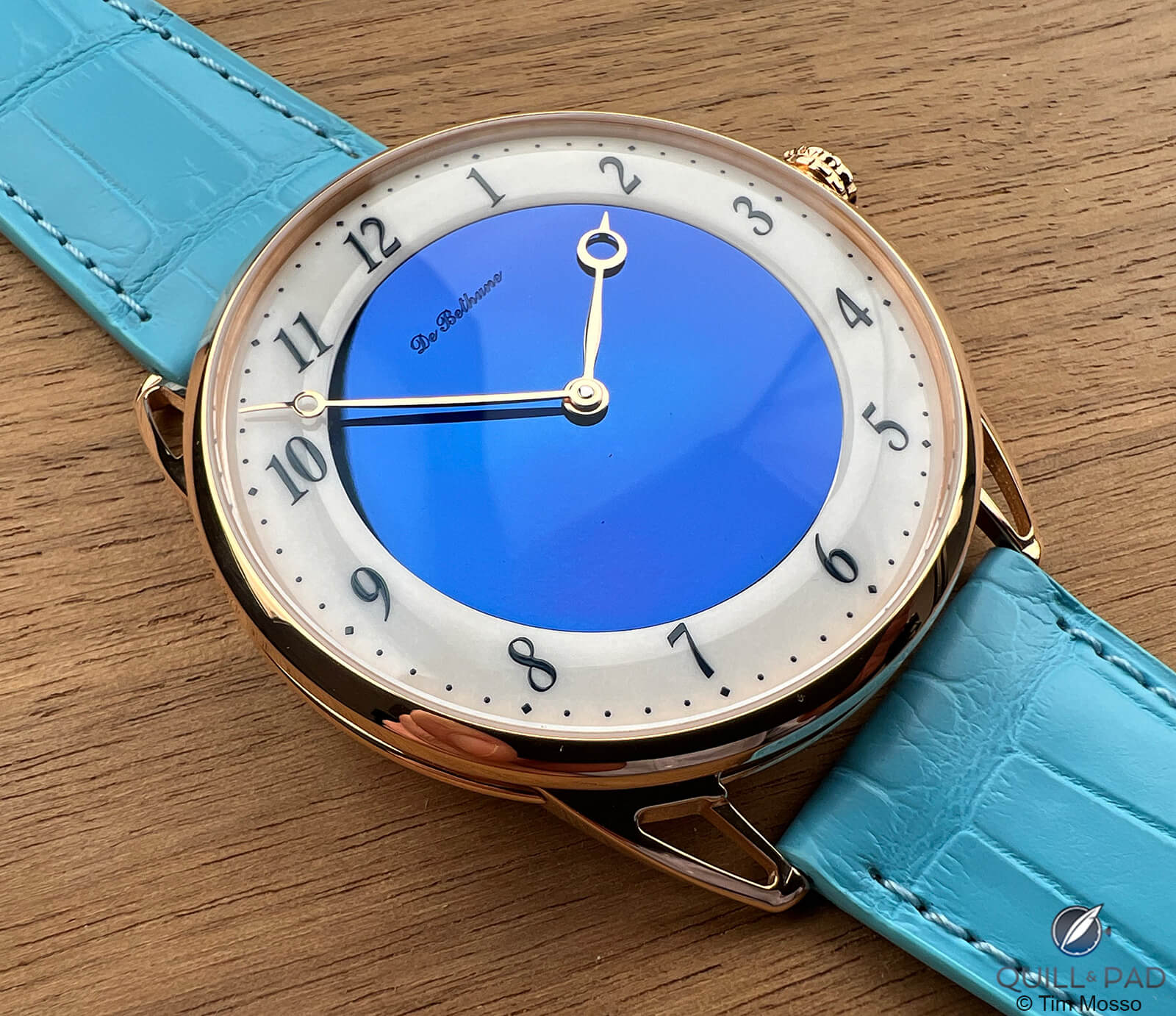
De Bethune DB25 Midnight Blue
To be sure, De Bethune, which is part of my extended corporate family, has some manic machines in the catalog. “Dream Watches” – yes, they’re called that – with space pod shapes and DB28s with spring-loaded lugs capture most of the mindshare when collectors visualize a De Bethune timepiece.
The “Kind of Two” series includes both spring-loaded lugs and rotating cases with double dials.
But collectors reared on mainstream independents like F.P. Journe or H. Moser & Cie. expect watches with round cases, solid dials, and lugs that don’t move.
Classicists migrating from legacy brands like Patek Philippe and Vacheron Constantin might like what they’ve got but crave the personal relationships, exclusivity, and bespoke touches that come with a small indie brand.
They’re not looking for a polemic on the wrist.
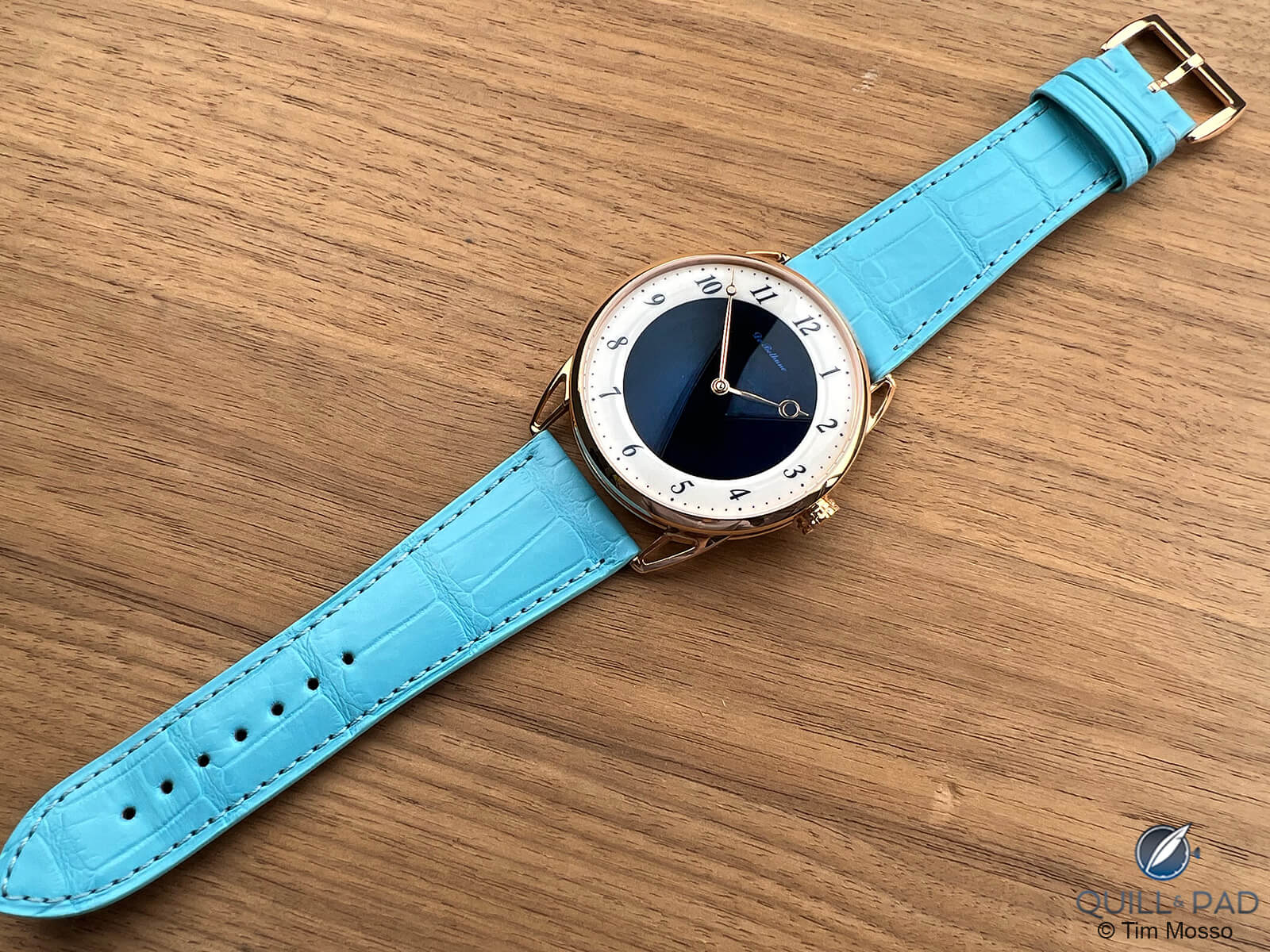
De Bethune DB25 Midnight Blue
That’s where the DB25 line comes in. Released in 2007 just as De Bethune was racing away from the neoclassical style of its early models, the DB25 was envisioned as a permanent home within the collection for some of those traditional design cues.
The “Midnight Blue” model featured here arrived in 2014 as a standard-bearer for the less-is-more crowd.
De Bethune watches rarely incorporate zero complications and only two hands, so on that basis alone the Midnight Blue is exceptional. Rarity also helps; only a few dozen have been built in the decade since the model’s launch. At 44mm, this is a large watch, but it’s also a thin one at only 10.3mm thick.
The look is broad-shouldered and strong without the self-conscious extroversion often repackaged as “boldness” by watch salesmen. The DB25 has a graceful, saucer-like breadth. Its spirit animal is a manta ray.
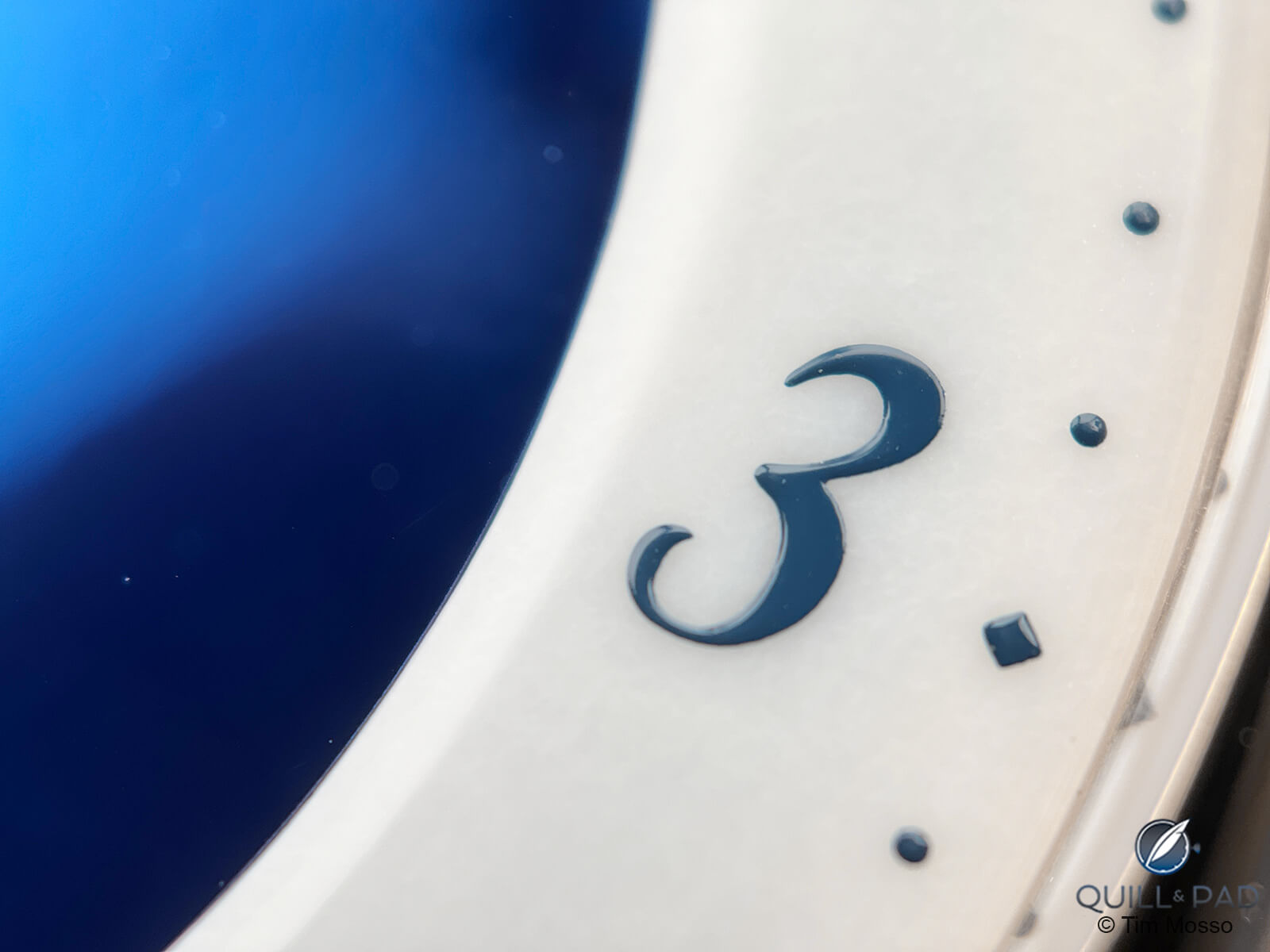
Fired enamel outer track of the De Bethune DB25 Midnight Blue
Dial side, God is in the details. The outer track is grand feu enamel fired up to 20 times and heated to 800 degrees Celsius. Rather than lying flat, it has a subtle arching camber that’s deep at center and shallow at its edges. Inboard, there’s a black-polished grade five titanium disc.
The mirror surface is achieved first, then kiln firing produces an oxide layer of sufficient depth to filter out yellow light. This is the same effect that prevails upon blued steel screws, but a flat and sprawling dial leaves no margin for marks, waves, or uneven heating.
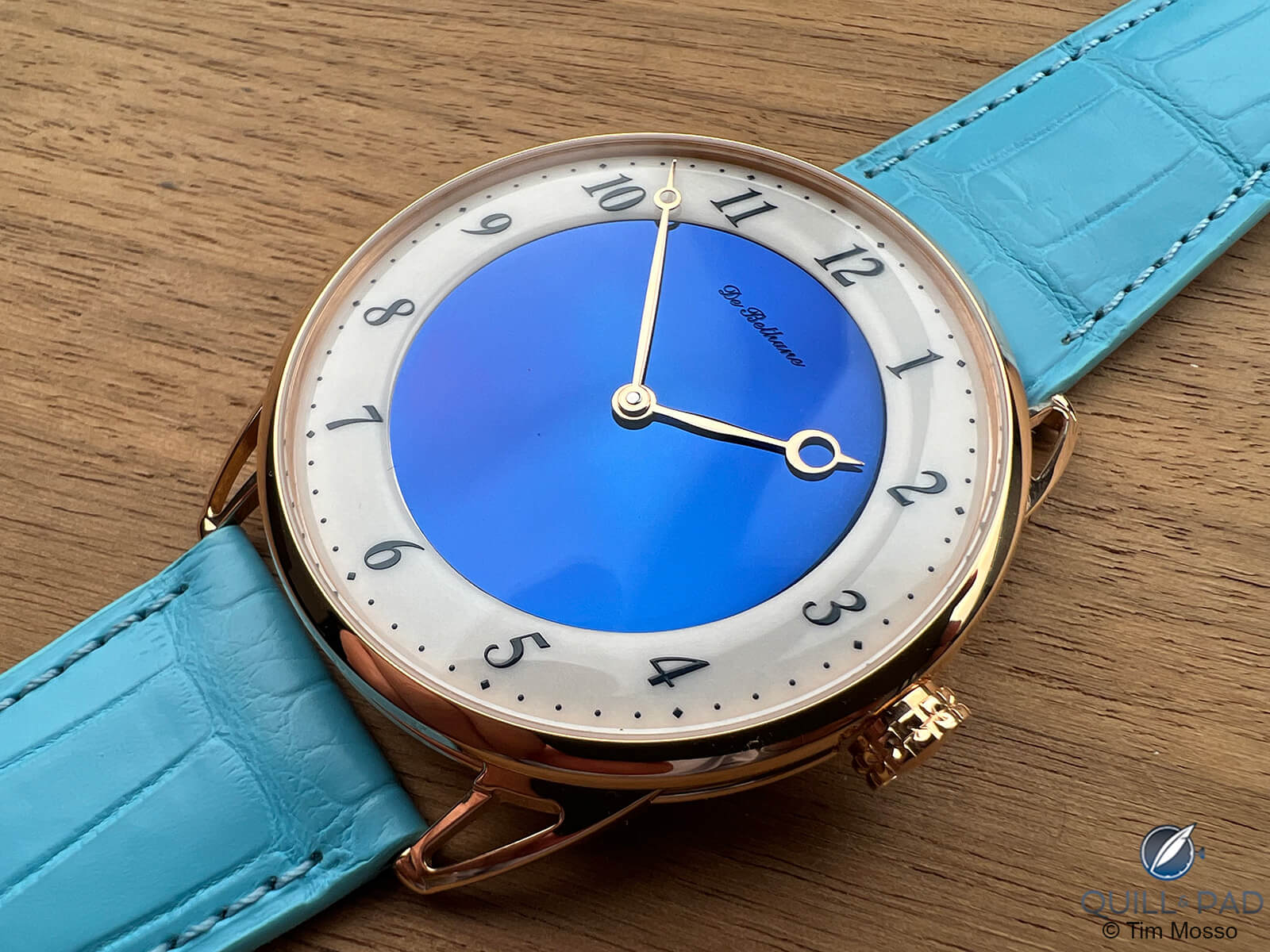
De Bethune DB25 Midnight Blue
Amid this tranquil sea of blue titanium and white enamel, the modest branding almost gets lost.
Modified Breguet hands in rose gold acknowledge one of De Bethune creator Denis Flageollet’s horological heroes. As with movements, both De Bethune dials and cases are constructed in-house.
Case composition is muted by DB28 standards, but it’s not entirely orthodox. De Bethune’s evacuated, buttress-like lugs have a light and prismatic quality. They’re open, airy, and short enough that this oversized watch measures only 51mm lug-to-lug.

De Bethune DB25 Midnight Blue on the author’s wrist
At 16cm, my wrist can wear it… just. The end profiles of the lugs are “ogival” or bullet-shaped homages to similar features on the 2002 DB1 chronograph, De Bethune’s first model. Character lines run circumferentially around the polished case, and an unbranded crown with drilled knurling adds subtle style.
If the DB25 collection faces any headwinds, it’s the common assumption that this is an entry-level series and not a full-fledged De Bethune like the DB28. In fact, the CHF 45,000 DB27, which looks like the DB28, is the point-of-entry in the catalog.
Turn over this CHF 60,000 DB25, and it’s clear that all the brand’s customary mechanical fireworks hide on the backside.
Again, the DB25 is a subtle De Bethune, not a lesser De Bethune.

View through the display back of the De Bethune DB25 Midnight Blue
Manufacture caliber 2024 arrived in 2006 and inaugurated the firm’s era of in-house automatics. Its standout feature is a massive blue titanium winding rotor with a white gold mass. Given the long lever arm of the broad rotor, it’s an efficient winder.
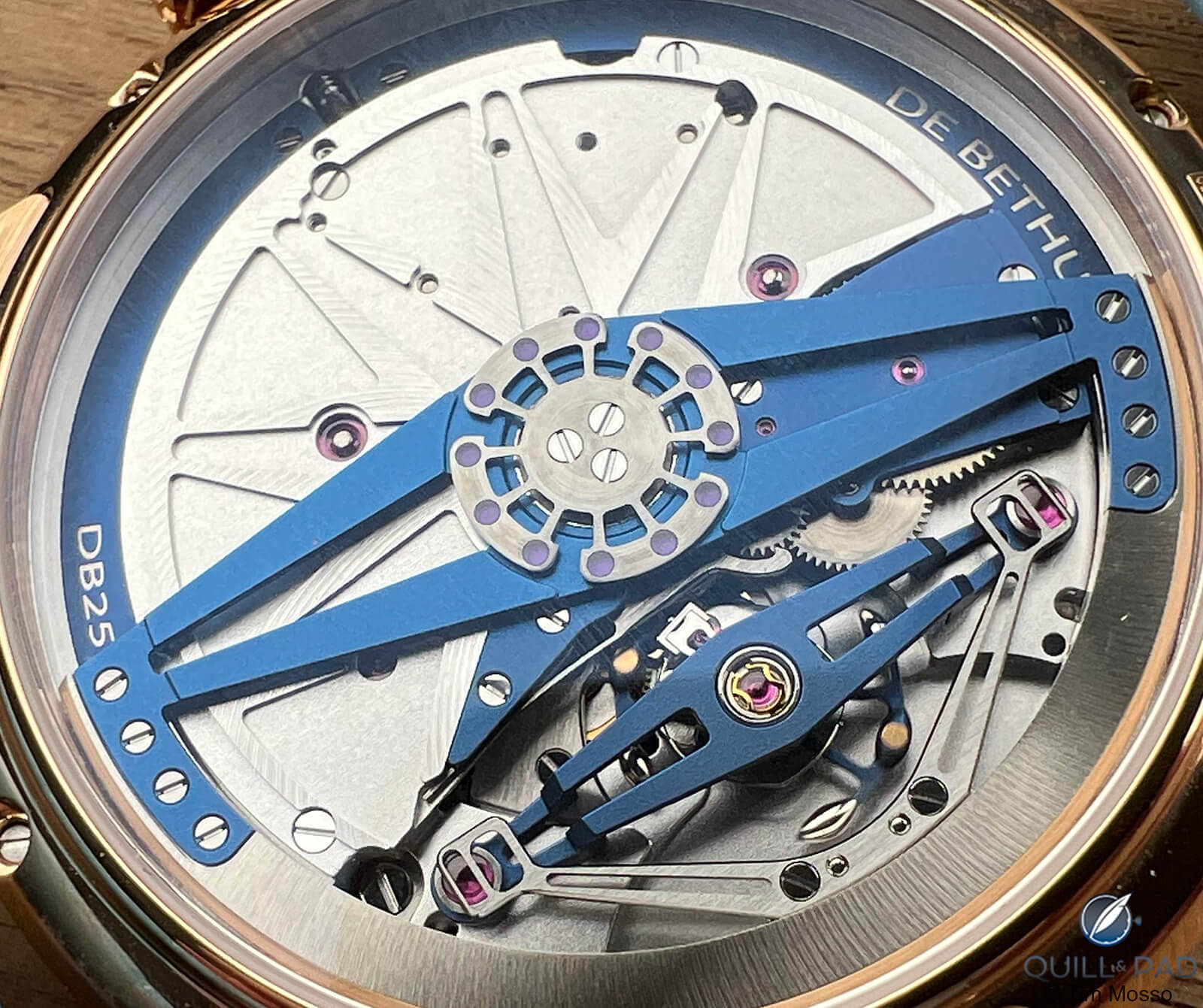
Automatic winding movement of the De Bethune DB25 Midnight Blue
However, such a long arm and huge mass can apply unwanted torsional – as opposed to rotational – forces on the ball bearing at center. The solution, which was patented, is the four-arm spring system over the rotor bearing. Each of the four springs is designed to keep the inner rotor arms from applying vertical torque to the bearings.
To reduce friction when the rotor arms contact the springs, each spring features three jewels ensuring smooth contact between the surfaces.
Twin mainspring barrels sit beneath a media-blasted and straight-grained barrel bridge. Combined, they enable a six-day power reserve. Most of the finish is austere by choice and suggestive of industrial chic.
The blue parts of the movement are fired titanium – albeit surfaced differently than the polished blue dial. Screw heads are polished, and the primary shock protection spring is micro-beveled on its flanks.
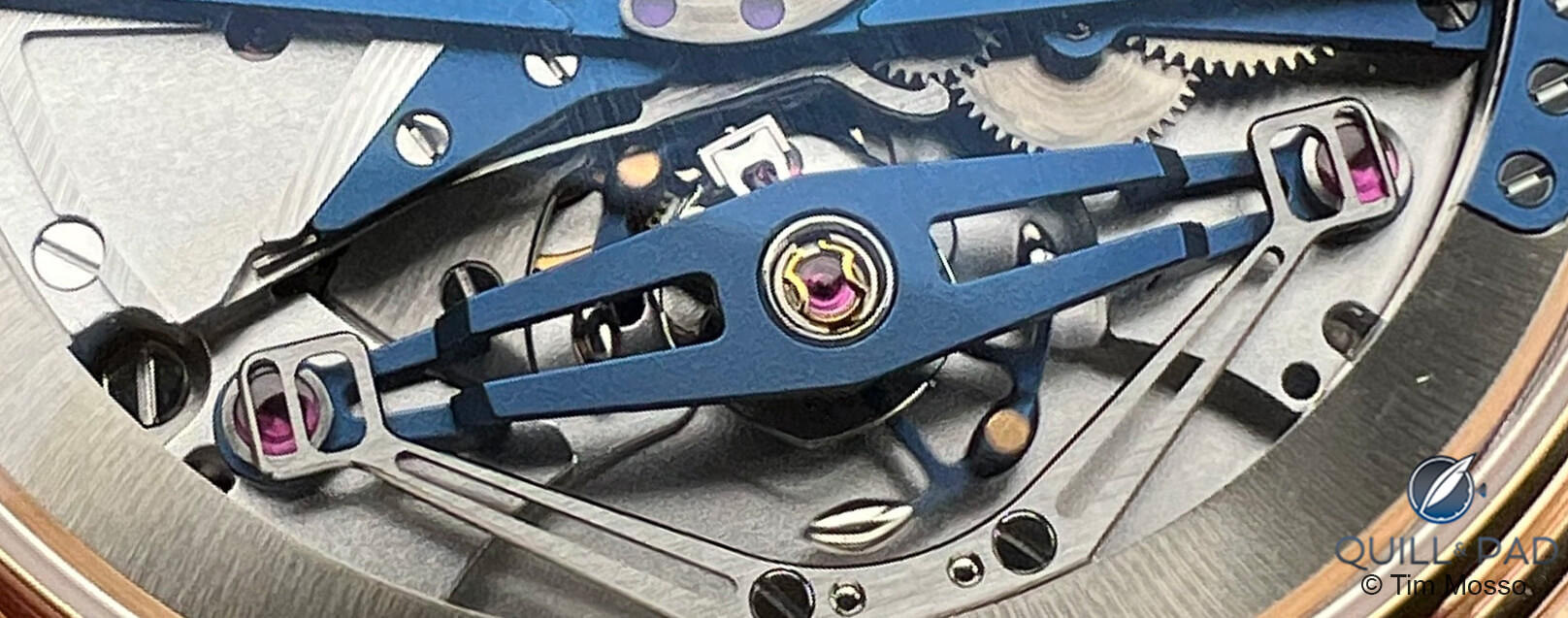
De Bethune patented triple pare-chute balance stem protection
About that spring: it’s part of a unique “Triple pare-chute” system that has been patented since 2005. Over the balance staff, conventional Incabloc provides proximate protection against fracturing the staff pivots.
But the overarching blue titanium balance bridge is tensioned at its ends by the finely finished steel pare-chute spring. Its first purpose is to combine with Incabloc for better preservation of the pivots.
The parallel purpose of Triple pare-chute is to ensure that the balance staff pivots spend less time displaced from their cup jewels; this improves the chronometry of the watch.
De Bethune goes through balance wheels like Britain goes through prime ministers. Since the inception of the brand in 2002, no fewer than ten unique designs have been patented.
Flageollet views the balance as the lynchpin of the entire movement, so he scraps the old design each time he’s able to make a meaningful advance in rim mass, aerodynamics, and resistance to temperature drift.
On the other hand, this makes each discontinued balance a milestone on the road, a collectible, and distinctive of its era. The example featured here is the 2008 model. Its non-annular yoke-like profile includes blued titanium arms with teardrop-profiled platinum masses.
At the center of the balance, De Bethune employs a unique hairspring curve that’s formed by hand. The process involves cutting the hairspring alloy, manually shaping the two profiles, and then mechanically rejoining them with a micro-clamp.
As a result, Flageollet achieves a hairspring with the thin profile and shock resistance of flat spiral but boasting the centered mass of an overcoil.
Some collectors start with restrained brands like Journe, Moritz Grossmann, or Lange, and then they work their way to the Urwerks, HYTs, and MB&Fs of the world.
On the other hand, many don’t accept that experience and exposure inevitably turn a man into 70s Elvis; simplicity can be a feature, not a bug. For those souls, even avant garde De Bethune has something to offer. The DB25 is an olive branch to classical conservatives.
For more information, please visit www.debethune.ch/en/collections/heritage/heritage-list/heritage-2014/db25-midnight-blue
Name: De Bethune DB25 Midnight Blue
Reference Code: DB25XPARV2
Case: Rose gold; 44mm diameter; 10.3mm thick; 51mm from lug-to-lug; 30-meters WR; 24mm between lug horns; push down crown
Clasp: Rose gold pin buckle
Dial: White enamel hour track and fired blue titanium center; rose gold hands
Movement: Caliber 2024, automatic with 144-hour power reserve; 4Hz, 49 jewels, twin mainspring barrels, 30mm in diameter
Functions: Hours and minutes
2024 Retail Price: CHF 60,000
2024 Preowned Price: $65,000-$70,000
* Tim Mosso is the media director and watch specialist at Watchbox. You can check out his very comprehensive YouTube channel at www.youtube.com/@WatchBoxStudios/videos. Watchbox is a shareholder in De Bethune.
You might also enjoy:
De Bethune DB28 Tourbillon Deadbeat Seconds reviewed by Tim Mosso
De Bethune DB Eight: The Ultimate in Chronograph Refinement!
De Bethune DBD Re-Edition Evergreen Reviewed by Tim Mosso
De Bethune DB28XS Starry Seas Reviewed by Tim Mosso
De Bethune DB28: How I Launched It, Why I Bought It, And Why It’s The Perfect ‘One Watch’
Leave a Reply
Want to join the discussion?Feel free to contribute!



The opening is apt, although I’d happily debate that perception IS reality and time is the construct during my fantasy diner party with Tim (other guests include King Charles III, Gary Neville, Ralph Lauren and Keanu Reeves in case you’re wondering).
What looks like a simple watch is actually stacked with incredible details, as clearly explained. Rather usefully Tim is my wrist doppelgänger but unfortunately, to my eyes, this watch is too big. Why is it so big?
Surely the measurement of 16cm is a typo?
16cm is the diameter of Tim Mosso’s wrist Marshall, not the watch case.
A 16cm wrist is relatively small.
Regards, Ian
16cm is above average for a human, thank you very much Ian!
Whoosh. So all humans have wrists 6-9 inches?
Not all, but my wrist is the same size as Tim’s 16.5cm/6.5″